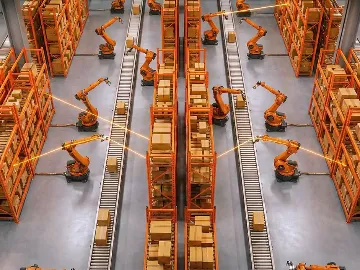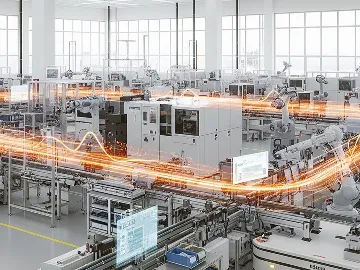Companies that use IoT development services and have already built a vast network of connected devices often find it challenging to visualize the data they produce. And since the number of IoT devices globally is expected to grow annually from 15.9B in 2023 to 39.6B in 2033, the problem of IoT data visualization will become evermore important. In this article, we'll discuss the role of data visualization in IoT, the technologies that enable it, the benefits the company may achieve, and how to overcome challenges related to IoT data collection and visualization.

What is data visualization in IoT?
IoT data visualization provides information collected from IoT devices and systems through various visual formats, such as charts, graphs, dashboards, heat maps, etc. The purpose of visualizing the data is to understand it easily, draw quick insights from it, and share it with stakeholders.
The process of data visualization in IoT includes several key steps:
- Data collection: data gathering and transmission to a central server or cloud for processing;
- Data processing: aggregation, filtering, cleaning, and transformation;
- Data storage: organizing databases for further retrieval by visualization tools;
- Data visualization: platforms and tools that transform data into selected visual formats.
You can visualize historical or real-time data from sensor-based devices, and both options are valuable for businesses. Real-time IoT visualization is handy for monitoring time-sensitive data in healthcare, manufacturing, automotive, or aviation industries. Historic data visualization may be beneficial for any businesses that want to benchmark performance and compare the results over specific periods of time.
Why is data visualization in IoT important?
The main point of IoT data collection and visualization is to break down large volumes of data and make it more "digestible" for business purposes. But this isn't the only reason the companies would like to present their IoT data in visual format.

It provides pattern and trend-identification capabilities
Visualization in IoT helps identify trends and patterns and trends in complex datasets that can further launch strategic initiatives and operational improvements. Converting raw data into intuitive visual formats enables users to detect correlations, monitor changes over time, and make data-driven decisions. This capability is crucial in industries ranging from manufacturing and healthcare to smart cities and environmental monitoring, where understanding patterns and trends can lead to significant operational improvements and innovations.
IoT data visualization can also highlight data deviation and anomalies. For example, when an unusual spike in sensor readings is detected, the IoT data visualization and notification system can alert users to investigate the issue.
It enables real-time monitoring and on-the-spot analysis
With real-time monitoring, businesses can promptly address issues and optimize performance. Dynamic, interactive, and context-rich visual representations of data allow users to quickly identify possible problems, make informed decisions, and take immediate action.
Many IoT data visualization platforms are cloud-based, allowing users to monitor systems remotely from any location. It's excellent for on-the-spot analysis by teams not physically present on-site or in environments where time-sensitive data can significantly impact operations, safety, and efficiency.
It enhances decision-making
Visualization tools can identify trends over time, such as increasing product demand or rising energy consumption. Recognizing these trends as soon as possible enables decision-makers to optimize strategies and resources. It also helps them implement new policies to align with predicted future states.
With real-time data, decision-makers can take proactive measures. For example, ecommerce Business Intelligence platforms visualize IoT tracking data from packages to prevent costly delivery failures and optimize logistics. For instance, if a machine shows signs of failure, real-time data visualization can indicate the need for maintenance before it causes production delays.
It helps share data and insights for strategic planning
Visualizing historical data alongside projections helps decision-makers plan for the long term. They can identify patterns and develop strategies that account for them, leading to more effective resource allocation and budgeting.
Visualization tools can compare current performance against benchmarks or industry standards, helping businesses identify areas for improvement or validate that their strategies are on track. Moreover, such solutions enhance communication of data findings to stakeholders, fostering better understanding and collaboration across different departments.
Adopting IoT data collection and visualization solutions provides businesses with a quick look into the performance of related devices. However, it takes a combination of other technologies to make it work.
Technologies that enable data visualization in IoT
IoT data visualization tools use processed data to present it in a visual format. Businesses obtain this data using data analytics, Big Data, Data Science, and other technologies. Let's review how they intertwine.

Data analytics
Data analytics is essential for IoT data visualization as it helps process and transform all raw data generated by IoT devices into meaningful insights. It cleans, aggregates, and organizes the data, making it ready for visualization tools to display in an understandable format.
Analytics helps identify patterns, trends, and anomalies in the data. Additionally, advanced analytics, like predictive modeling, can visualize future trends, which can be useful during proactive planning.
Explore more: Data visualization consulting to improve your decision-making
Big Data
Big Data provides necessary tools to collect, store, process, and analyze IoT data in real-time, ensuring that the most relevant information is available for visualization. These technologies help uncover patterns, trends, and correlations within the data for further visualization. By handling IoT data's scale, velocity, and variety, Big Data ensures that visualization tools can deliver meaningful, real-time insights.
Cloud
Cloud provides scalable infrastructure for managing IoT data at scale. It allows real-time data streaming and processing, ensuring that visualizations are up-to-date and responsive, even as the volume of data grows. The cloud also facilitates the integration of data from multiple sources, offering a unified platform for comprehensive and consistent visualizations.
Case in point, N-iX has partnered with Gogo, a global provider of in-flight connectivity and Internet, currently serving over 16 commercial airlines. Their on-premises infrastructure couldn't collect and aggregate structured and unstructured data from over 20 sources necessary for the project. Our team moved the data operation to the AWS cloud, expanding the computing capabilities, creating an environment that supported further modernization processes, and improving performance.
Artificial Intelligence and Machine Learning
Artificial Intelligence (AI) and Machine Learning (ML) enable IoT data visualization by automatically analyzing and interpreting complex IoT datasets, identifying patterns, trends, and anomalies that might not be immediately apparent. They help generate predictive insights, such as forecasting future trends or detecting potential failures, which can be visually represented for proactive decision-making. Additionally, these technologies can process and visualize data in real-time for the most up-to-date insights, and make visualizations evolve based on new data insights.
In the Gogo case, for example, we have created Data Science and ML algorithms for predicting satellite and antenna failures. It helped the business improve its predictive analytics and monitor equipment health to prevent connectivity failures.
Recently, AIoT (a combination of AI and IoT) has become a popular technology among businesses that want to enhance automation, continuous data processing at scale, and real-time network optimization. AI components can also enable personalized visualizations, tailoring them to specific user needs or automatically highlighting critical data points. Companies can also benefit from on-device AI, which accelerates IoT device data processing, decreases latency, and cuts cloud computing costs.
Master data complexity with Generative AI – access the guide now!


Success!

Augmented Reality and Virtual Reality
Augmented Reality (AR) and Virtual Reality (VR) provide immersive, 3D environments where users can interact with data in more intuitive and spatially meaningful ways.
AR overlays IoT data onto the physical world, allowing users to see real-time information, such as equipment status or environmental metrics, directly in their field of view. VR creates fully immersive simulations where complex IoT data can be explored in a virtual space, offering deeper insights into spatial relationships and system behaviors.
These technologies enable users to visualize and manipulate data in real-time, improving situational awareness and decision-making.
Edge computing
Edge computing helps process information closer to the source, reducing latency and ensuring that visualizations can be generated in real-time or near real-time. Handling data locally at the edge helps reduce bandwidth usage and costs by filtering and analyzing data at the source, only sending essential information to centralized systems for further visualization.
This local processing capability allows for real-time monitoring and decision-making, especially in environments where immediate responses are crucial, such as in industrial automation or healthcare.
An expert provider of IoT and Data Science services can use these technologies for your visualization projects and help you gain more visibility into your data. Let's review the best practices your business should follow to effectively capture and present data visually.
Best practices for effective IoT data visualization

Consolidate IoT data sources
With the cost of IoT devices and hardware decreasing, more companies adopt IoT solutions. These connected devices provide enormous amounts of data, causing data deluge. If your IoT devices produce more data than your system can process, you have a higher chance of visualizing the information with little value.
Consolidating IoT data sources ensures consistency and accuracy by centralizing data into a unified platform. This approach simplifies data management, making correlating and analyzing information across different devices and systems easier. It also improves the quality of insights by reducing redundancy and ensuring that visualizations are based on a comprehensive data view.
Decide the type of data you want to visualize
Whether you need to visualize historical data or get insights from events occurring in near real-time, different approaches are required. For example, visualization of near-real-time data will require more computing power on the edge to ensure instant data processing and management. On the other hand, visualizing historical data will require more cloud, data storage, and governance resources as it will deal with already cleaned datasets. It is one of many factors you should consider when choosing data for visualization.
Focusing on the most critical data can create clear, actionable visualizations that directly address the key questions or challenges at hand. It will also help you avoid information overload, making interpreting and acting on the data easier. Moreover, selecting the appropriate data type helps choose the right visualization tools and methods, enhancing the effectiveness of the visualization.
Ensure data quality
The rule "garbage in, garbage out" can also be applied to IoT data analytics and visualization. Visualization requires the data to be ready for further processing, which means cleansing, filtering, and formatting it prior to feeding it into the visualization tool.
Incomplete, inconsistent, or erroneous data can lead to misleading visualizations, resulting in incorrect decisions. By ensuring data quality, you enhance the trustworthiness and effectiveness of the visualizations, making them more useful for decision-making. Additionally, clean and accurate data allows for more precise trend identification, pattern recognition, and anomaly detection, which are critical in IoT environments.
Use the correct visualization technique
The proper visualization technique-whether it's a line graph, heatmap, or dashboard-makes it easier to understand complex data, spot trends, and identify patterns. Choosing an inappropriate format can lead to misinterpretation or confusion, undermining the effectiveness of the visualization. Selecting the correct technique enhances clarity, insight, and decision-making, making the data more actionable.
Ensure visual data shareability across the stakeholders
Sharing visual data with stakeholders facilitates collaboration, transparency, and informed decision-making. It helps all stakeholders-regardless of their technical expertise-access, understand, and contribute to discussions based on the same accurate and up-to-date information. This shared access helps align teams, promotes interpretation consistency, and supports faster, more coordinated responses to insights derived from the data.
Keep IoT data secure
Secure data handling ensures that the visualizations are based on trustworthy data, maintaining the integrity and reliability of the insights provided. It helps prevent compromised visualizations, misleading conclusions and potentially harmful decisions. Additionally, securing IoT data helps comply with regulatory requirements, safeguarding both the organization and its stakeholders.
Explore further: How to ensure IoT security across system levels: a comprehensive guide
Allow personalization
Personalized visualizations ensure that each user sees the most relevant data in the most meaningful way. Filtering, sorting, exporting, design or other personalization options allow users to customize their dashboards to focus on specific datasets or metrics of interest. For example, a user might create a custom view highlighting only the data from devices showing irregular behavior over the past month, making it easier to spot emerging trends. This approach reduces information overload by filtering unnecessary data and focusing on key metrics for specific users and projects.
In addition to applying the best practices, companies should consider the challenges of adopting IoT data visualization solutions and prepare mitigation strategies. Here are the most common IoT data visualization challenges and how to overcome them.
IoT data visualization challenges and how to deal with them
The challenges of IoT data visualization concern the quality and quantity of data, its security, diversification, and the lack of experts who can implement the right technologies to address these issues. Let's discuss them in more detail.

Data overload
IoT systems generate massive amounts of data, making presenting relevant information clearly or retrieving necessary insights difficult.
Solution: Implement data aggregation techniques to summarize key metrics and use filtering tools to focus on important data. Interactive dashboards can allow users to drill down into specific details as needed. Use real-time data processing and customizable dashboards to help users focus on key metrics, ensuring that the visualization remains clear and actionable despite the large data volume.
Oversimplification of data
Data visualization aims to simplify complicated datasets. However, oversimplified representations may sometimes miss crucial data aspects.
Solution: Use layered visualizations that allow users to drill down into more detailed data as needed. You should also combine multiple visualizations to present high-level summaries and granular insights.
Diversified data sources
IoT data comes from various sources, formats, protocols, and structures, complicating integration and visualization. This diversity can lead to inconsistencies, data integration issues, and challenges in creating unified visualizations that accurately represent the complete picture.
Solution: Use data integration platforms to standardize and harmonize data from different sources. Adopting flexible data models and connectors, data integration platforms or middleware can help unify disparate data streams.
Scalability
As the number of IoT devices and amount of data points they generate grows, visualizations can become slow or unmanageable, especially in real time. This can lead to performance bottlenecks, slow data rendering, and difficulties maintaining visualization clarity and responsiveness.
Solution: Implement scalable cloud-based infrastructure and distributed data processing tools that can handle large datasets efficiently. You can also use data aggregation and filtering methods to reduce the load on visualization systems.
Security and privacy concerns
Sensitive data from IoT devices may be exposed to unauthorized access or breaches during visualization, especially when transmitted or stored improperly. This risk can undermine trust in the data, lead to compliance violations, and potentially expose confidential information.
Solution: Incorporate strong data encryption, access controls, and anonymization techniques, and use other relevant IoT security services from reliable vendors. Ensure that data visualization tools comply with relevant data protection regulations and standards.
Erroneous data processing algorithms
If the algorithms fail to process or interpret the data correctly, the resulting visual insights may not reflect the system's true state, causing users to draw incorrect conclusions.
Solution: Validate and test data processing algorithms to ensure their accuracy and reliability. Implementing error-checking mechanisms and continuously monitoring their performance can also help detect and correct issues before they impact the visualizations.
Skill gap
The tech skill gap limits the organizations' ability to effectively implement, manage, and interpret complex visualizations, especially when specialized knowledge is required to handle diverse IoT data sources and advanced visualization tools. This gap can lead to underutilization of available data, misinterpretation of insights, and slower decision-making processes.
Solution: Invest in targeted training programs to upskill their workforce in data visualization and IoT technologies. You can also extend your IoT department or use custom IoT development services from experienced software development companies like N-iX with strong IoT, data analytics, and Data Science expertise.
Read more: Top 15 data visualization companies on the global market
How can N-iX help you visualize IoT data?
N-iX has experienced Data Science and IoT units with over 200 experts on board. Over the past 23 years, we've helped manage data and its presentation for international enterprises from finance, manufacturing, logistics and supply chain, retail, telecom, automotive, healthcare, energy and utilities, and agritech.
Our services in the IoT data visualization domain include designing, developing, and deploying custom visualization solutions, data integration and management, development of scalable and secure IoT platforms, and integration of Gen AI, AI, ML and other technologies. N-iX experts specialize in software engineering, cloud solutions, RPA and enterprise platforms, cybersecurity, embedded, AI, ML, Data Science, data analytics, IoT, and UI/UX. They can help you create a visualization solution tailored to your requirements.
If you need to improve IoT data management and expand visualization capabilities, contact our team. Let's discuss how our vast tech expertise can serve your business needs.
Have a question?
Speak to an expert




